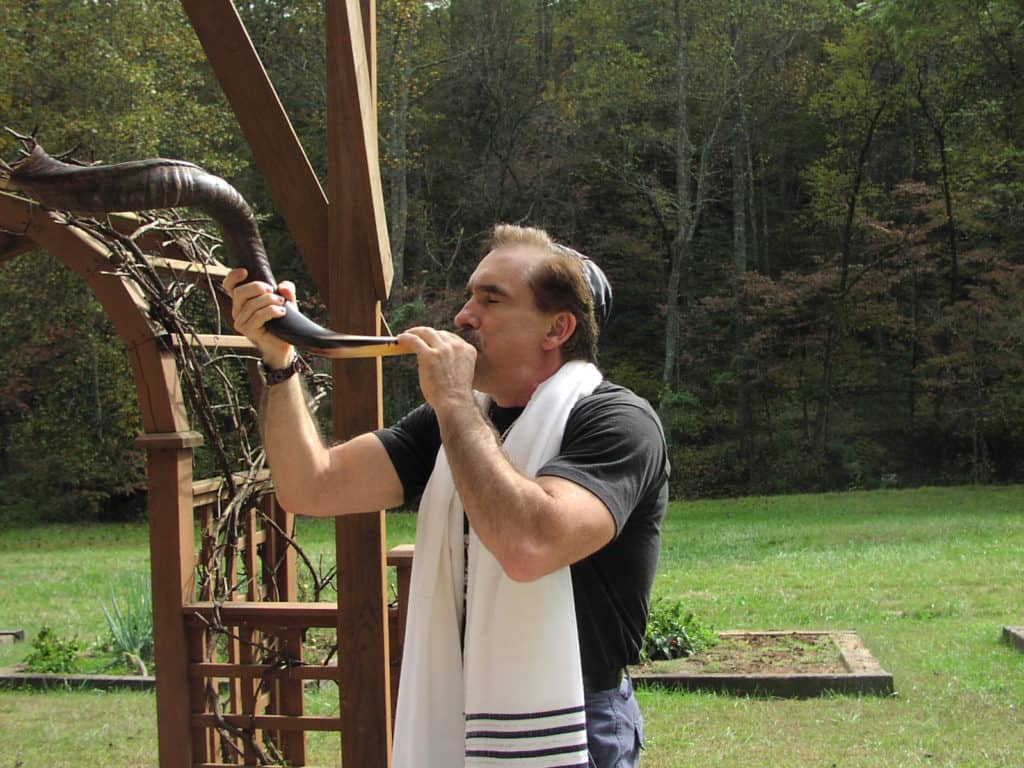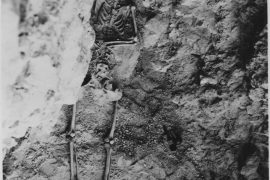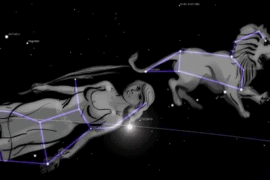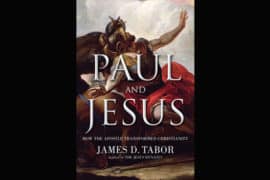Cry aloud to God our strength, raise a shout to the God of Jacob.
This evening at sundown the Jewish holiday popularly known as Rosh HaShanah begins. Literally, rosh ha-Shanah ( ראש השנה) means “head of the year.” It is commonly included on our secular calendars today as one of the “Jewish Holidays,” along with Passover and Yom Kippur, and is widely known as the “Jewish New Year.” Surprisingly though, on the Jewish calendar it is the 1st day of the seventh month, not the first day of the first month–so how could it mark a new year?

In biblical times, and on the Jewish calendar today, the “months” are lunar months, marked by the appearance of the “new moon,” 12 or 13 times in a solar year of 365.25 days. Judaism has two ways of marking the beginning of a year. The term “year” in Hebrew, shanah/שׁנה, is related to a verbal root meaning “to change” or “to turn.” Accordingly, one can refer to the “turning” of a year. The seasonal New Year is the first day of the first month, as Exodus 12: 1 puts it:
This Moon/month shall be to you the beginning (rosh, lit. “head”) of months.”
I suppose one could call it the original or primary “Rosh HaShanah,” as it comes with the beginning of the Spring and is therefore tied to the barley harvest and its seasonal ripening. That day is very significant in biblical and Jewish history as many events have taken place on Nisan 1st–the biblical New Year, marking times of “new beginnings” (Exodus 40:2; 2 Chronicles 29:17; Ezra 7:9; 10:17).
The “Jewish New Year” that begins at sundown tonight falls on the 1st day of the 7th lunar month–as Fall begins. It marks the beginning or “turning” of a different kind of year, one that in ancient times had to do with certain calculations regarding the Jubilee, the redemption of bond-servants, and so forth. It is kind of a “legal” New Year, much like our July and Oct “fiscal years” in our society today, having to do with land redemption and financial arrangements. More anciently it was apparently connected to agricultural festivals of “ingathering,” beginning with the grapes and olives, according to the Gaza calendar, see Karel van der Toorn’s excellent analysis here: “Rosh Hashanah with the Early Israelites.”
In the Torah itself this holy day is never called Rosh HaShanah. Rather it gets a different name–Yom Teru’ah, that is “day of the blast.” Teru’ah/תרועה in Hebrew refers to raising up a loud noise, whether the shout of a human voice, such as a battle cry, or the piercing sound of a shofar or “trumpet” as a call of assembly or alarm–much like our modern concept of a siren. Thus many Christian groups that keep this day refer to it as the “feast of Trumpets,” though that phrase never occurs in the Hebrew Bible.
The instructions in Leviticus 23, where all the biblical festivals and sabbaths of the Jewish calendar are laid out, are amazingly sparse. Absolutely no hint as to its purpose or meaning is given. It is a “memorial” or “marking” of something, but of what? There one is simply told:
Speak to the people of Israel, saying, “In the seventh month, on the first day of the month, you shall observe a day of solemn rest, memorial of teru’ah, a holy convocation (Leviticus 23:24).
This is quite literally a “commemoration” announced by a blasting sound–whether of shouting or that of a shofar. There is very little else about this day in the Hebrew Bible other than Nehemiah 8. There we read that on the first day of the seventh month Ezra the scribe assembled all the Returnees from Babylonian Exile and read to them, from dawn until noon, the “Scroll of the Torah [Teaching] of Moses,” causing the people to weep over their sins as they listened. However, Ezra and Nehemiah then urge the people to not turn the day into sadness but rather hope and rejoicing. They are told “Go eat choice foods and drink sweet drinks and sent portions to whoever has nothing prepared, for the day is holy to our Lord, do not be sad, for your rejoicing is the source of your strength” (v.10). So here we see a looking back in introspective examination but also a looking forward in hope. These Returnees had established again in the Land of Israel a tiny beachhead of hope for fulfilling the Abrahamic Plan of Genesis 12:1-3–to bless and bring light to all nations.
Clearly this is not the modern Torah Scroll of Genesis 1:1 through Deuteronomy 34:12, but a smaller “scroll” that Moses wrote, referenced in Deuteronomy 31:24. It was variously called “this Teaching,” “the scroll of the Teaching,” the “scroll of the Teaching of Moses,” and the “scroll of the Teaching of God.” It was put in the “side” of the Ark of the Testimony–the wooden chest holding the Ten Words, written on the two tablets of stone. It was also written on plastered stone by Joshua on Mt Ebal and again, and as in the time of Ezra and Nehemiah, read aloud to the people (Deut 27:8; Joshua 8:34-35). It is this book that is found in the reign of young king Joshua, in the time of Jeremiah (2 Kings 22:8). Some scholars have suggested that portions of Deuteronomy, especially those sections written in the first person by Moses, reflect the contents of that original “Scroll of the Teachings of Moses.”
Another clue as to the ancient meaning of this day is found in Psalm 80 & 81. This day, of the new moon, is associated with a “trumpet,” or more properly, a “shofar,” in Psalm 81, coupled with the word teru’ah or “shout.”
Cry aloud to God our strength, raise a shout to the God of Jacob.
Lift up a song, and give out a timbrel, a pleasant harp with psaltery.
Blow in the month a shofar, in the new moon, at the day of our festival,
For a statute to Israel it is, an ordinance of the God of Jacob.
A testimony in Joseph He hath placed it, in his going forth over the land of Egypt (Psalm 81:2-6).
The connection here to the tribe of Joseph is quite interesting. Joseph–the lost son of Jacob–whose name, along with that of his son Ephraim, later becomes associated with the scattered Northern Tribes of Israel (see Ezk 37:15-24). He of course lost his “identity,” and became unknown to his brothers, living among the Gentiles.
The Hebrew Prophets have connected the sound of the shofar as a call to the scattered 12 Tribes of Israel to regather in the Land of Israel–perhaps the most dominant theme in the Prophets (Jeremiah 23:5-8; 30:1-3; 33:27-40):
In that day from the river Euphrates to the Brook of Egypt the LORD (YHVH) will thresh out the grain, and you will be gathered one by one, O people of Israel. 13 And in that day a great trumpet will be blown, and those who were lost in the land of Assyria and those who were driven out to the land of Egypt will come and worship the LORD on the holy mountain at Jerusalem (Isa. 27:12).
Associations of the blast of a Shofar with messianic times is quite explicit in the prophet Zechariah. In the special Oracle or Pronouncement of chapters 9-11, the “king comes to Zion” bringing a rule that extends from sea to sea and from ocean to land’s end” (Zech 9:9-10). In that section Jehovah/Yahweh himself takes up the Shofar to announce this messianic victory, reflecting the language of the Exodus and His epiphany at Sinai/Horeb (cf. Deut 33:2; Psalm 68:18):
And the LORD (YHVH) will appear over them, and his arrows shall flash like lightning; My Lord YHVH shall sound the Shofar, and advance in a stormy tempest (Zech 9:14).
Later, as the messianic and eschatological expectations of both Jews and Christians developed in the Late Second Temple period (300 BCE to 70 CE), the idea of the blowing of a final Trumpet of Judgment began to develop. It came to be associated with a call or warning of impending judgment and even the resurrection of the dead. Paul writes that the return of Jesus in the clouds of heaven and the resurrection of the dead will commence with the “sound of the trumpet of God” or “the last trumpet” (1 Thessalonians 4:16; 1 Corinthians 15:52). In the gospel of Matthew the “elect” or chosen ones, which would make up a kind of “true Israel,” are gathered at the end of days by the sound of a “loud trumpet” (Matthew 24:31).
Since this day of Teru’ah comes ten days before Yom Kippur, the solemn day of “covering” or atonement, the blast of the shofar was thought to signal a call to introspection and judgment. The rabbis believed that “ten days of awe,” between the two festivals are a time when the world stands in judgment and the doors of repentance are open. This view, which has become the standard perspective of Judaism today, predominated. The rabbis emphasize that whereas Passover, which falls in the first month of the Jewish calendar, celebrates the freedom of Israel from slavery in Egypt, this “Day of the memorial Blast,” that falls in the seventh month, is a call to all humankind to stand before God in judgment.








Comments are closed.